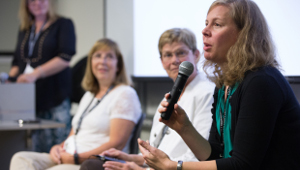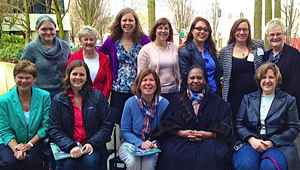A GHRI staffer’s dispatch from the 2015 Stanford Medicine X Conference

Susan Brandzel, MPH, moderates at Stanford’s prestigious conference
At a recent Silicon Valley meeting, Susan Brandzel fulfilled a high school prophecy. And she learned and shared about how patients are transforming care.
by Susan Brandzel, MPH, Group Health Research Institute project manager
When I graduated from high school many decades ago, I was voted “Most Likely to Be a Talk Show Host.” When I got my Master of Public Health degree from the University of Washington, I was sure I had proved my classmates wrong. But last weekend, I realized that this high school prediction had come to fruition.
I facilitated a panel presentation about patient engagement in research at the 2015 Stanford Medicine X conference. This annual meeting is quite new and still finding its identity. In some ways, though, its location is indicative of its intentions. Based at the medical school of one of the world’s most prestigious academic institutions, in the heart of Silicon Valley, Medicine X examines the confluence of medicine and technology, with a focus on patient centeredness.
 |
| Dr. Karen Wernli speaks at Stanford Medicine X. |
I attended Medicine X because I'm the project manager and resident “talk show host” for SIMBA, a Group Health Research Institute (GHRI) study about mammography and MRI for breast cancer survivors. Our research team—made up of patient partners Dianne Johnson and Mary Bush, GHRI Assistant Investigator Karen Wernli, PhD, and me—was invited to talk about our three-year, $2 million project that included Ms. Johnson and Ms. Bush in central aspects of the study including scientific discussions, administrative planning, and writing about the study for scientific journals.
For 45 minutes, we talked about what we expected when we started working together in this collaborative capacity and what being or having patients participate in research really turned out to be like. We spoke enthusiastically about the great benefits that including patient partners on the team has had for our project, such as the times they accompanied Karen and me to focus groups we held around the country with other women with a history of breast cancer. Their presence at these events bridged the notorious gap between researchers and patients and put the participants at ease. We also spoke candidly about the challenges we faced in implementing this non-traditional approach to epidemiologic research, including the need to regularly translate technical terminology for the patient partners.
Although our audience at the conference was small, the feedback was resoundingly positive. And it enabled us to reflect upon all we have learned along this journey: mainly what a unique contribution patients can make to the conduct of medical research.
Other patients tell of influencing care
One of the most inspiring main stage presentations at Medicine X included an interview with 91-year-old inventor Barbara Beskind, an innovation consultant at the global design firm IDEO. Beskind, who is legally blind as a result of macular degeneration, entered the stage guided by one of her inventions, two lightweight sticks resembling ski poles that help her balance and navigate. She not only spoke about but poignantly demonstrated the value that the voice of an older adult can contribute to improving health care for people her age. The projects she has helped IDEO develop stand to dramatically improve functionality and quality of life for older members of our society.
Another remarkable speaker who highlighted the critical importance of patient-centered health care was Ben Bahan, PhD, professor of American Sign Language and Deaf Studies at Gallaudet University. Born to deaf parents and deaf himself, Bahan depicted, in a compellingly animated manner, a common non-hearing patient’s experience in the health care system. No matter why they visit the doctor, their hearing loss is always the first topic broached, even when it is completely unrelated to the purpose of the visit.
The point of Bahan’s charismatic and emotional presentation was to encourage those who have the potential to influence health care to keep care relevant to the patient's needs. He urged people to put their curiosity about a patient’s “differentness” aside, unless it is part of the clinical puzzle at hand.
We are entering a new era in health care, one that aims to make it more efficient and effective. And with the help of conferences such as Stanford Medicine X, this paradigm shift will include making care more relevant and meaningful to patients who are looking to the health care system to maximize their quality of life. GHRI was one of the first recipients of funding from the Patient-Centered Outcomes Research Institute, which supports studies like SIMBA that are guided by patient input, demonstrating our commitment to ushering in this new model for health care. I’m honored to be part of that process.




